
Our specialists will give you a beautiful nose that suits you.
When viewed from the front, the nose is at the center of the face, giving a sense of its volume and presence.
When viewed from the side, it contributes greatly to a person’s profile.
The three-dimensionality of the face is influenced by the height of the nose, and the line of the nasal dorsum.
For those who want to make their nose taller, or make their round nose elegantly thinner, or adjust the shape of their nose, we will propose the best method to meet your wishes.
Nose Surgery List(Rhinoplasty)
Underneath is a detailed description of each nose surgery procedure, including case photos, progress photos, procedure period, post-operative care, symptoms, risks, side effects, and complications.
Caudal Septal Extension Graft Surgery (Lengthening of a Short Nose)
Nasal Implant Removal
Nasal Implant Exchange
Nasal Base Reduction
Nasal Tip Plasty
Blunt Nasal Tip Correction
Long Nose Correction
Alar Rim Resection
Alar Rim Graft
Augmentation Rhinoplasty
Hump Nose Correction
Osteotomy
Glabellar Augmentation Rhinoplasty
Revision of Nasal Base Reduction
Paranasal Augmentation
Deviated Nose Correction
Alar Rim Raising
Revision of surgery done at another clinic
Search by your concerns
For those who want to make their nose taller
Augmentation Rhinoplasty
Custom-made prosthesis for your desired look
Glabellar Augmentation Rhinoplasty
Replenishes the height between the eyebrows and smoothes the contour from the forehead to the nose
Caudal Septal Extension Graft Surgery (Lengthening of a Short Nose)
A downward nose, less noticeable nostrils, and higher nose tip
Long Nose Correction
For those who want to lift a drooping nose
To reduce the roundness of the nose (button nose)
Nasal Tip Plasty
Shape the tip of your nose
Blunt Nasal Tip Correction
A nose that is slender from the front and sharp from the side
Caudal Septal Extension Graft Surgery (Lengthening of a Short Nose)
A downward nose, less noticeable nostrils, and higher nose tip
For those who want to make their nose smaller and more modest
Nasal Tip Plasty
Shape the tip of your nose
Blunt Nasal Tip Correction
A slender nose from the front and sharp nose from the side
Nasal Base Reduction
A smaller nose, narrower width, less noticeable
Alar Rim Resection
Lift the nostril edges upward to make the nose slimmer
For those who want to shape their nose downward
Caudal Septal Extension Graft Surgery (Lengthening of a Short Nose)
A downward nose, less noticeable nostrils, and higher nose tip
For those who want to improve the appearance of their nostrils
Caudal Septal Extension Graft Surgery (Lengthening of a Short Nose)
A downward nose, less noticeable nostrils, and higher nose tip
Alar Rim Graft
For those with prominent, raised nostril edges
Alar Rim Raise
Lift the drooping nasal wings
For those who want to improve a crooked nose
Deviated Nose Correction
Straighten a crooked nose
Nasal Implant Removal
No scars will be visible as the implants are exchanged through the nostrils
Hump Nose Correction
Shave off the hump and straighten the nasal dorsum
Osteotomy
Thin out thick nose line, straighten crooked nose line
For those who want to revise previous rhinoplasty done at other hospitals.
For those who want to revise previous rhinoplasty done at other hospitals.
Nasal Implant Exchange
No scars will be visible as the implants are exchanged through the nostrils
Removal of Nasal Implant
No need to worry about scars as the implant is removed through the nostrils
Osteotomy
Thin out thick nose line, straighten crooked nose line
Caudal Septal Extension Graft Surgery (Lengthening of a Short Nose)
A downward nose, less noticeable nostrils, and higher nose tip
Nasal Tip Plasty
Shape the tip of your nose
Nasal Base Reduction Revision
Nasal Wings Deformity Correction
Anatomy of Nose

Under the skin, there is subcutaneous fatty tissue, and the structural tissues that support the nose are the alar cartilage, septal cartilage, lateral nasal cartilage, and nasal bones.
Many oriental noses have thick skin and fatty tissue, as well as poorly developed cartilage and bone.
Nasal surgery can correct all of these perceived negative aspects of an oriental nose.
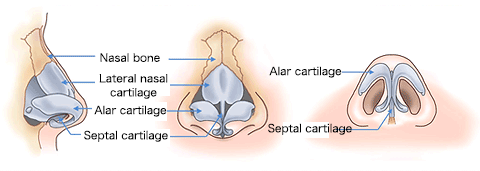
The figure below is a cross-sectional view of the nose cut in the middle.
The septal cartilage is supported by the nasal bone above, the ethomoid bone perpendicular plate behind, and the vomer and maxillary bones below.
The anterior upper part of the septal cartilage is a key structure to consider during surgery. It is relatively soft and thin, making it easy to move the tip of the nose laterally.
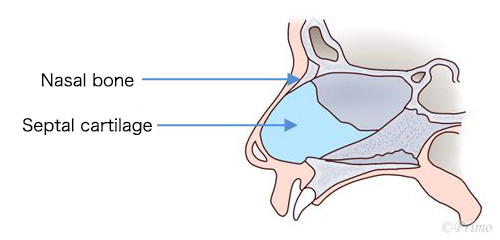
Balance of the Face
The nose is at the center of the face, and the size and width of the nose has a significant effect on the balance of the face.
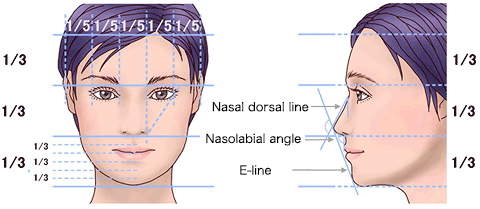
Profile of the side of the nose
About the nasal dorsum line

The nasal dorsal line from the nasal root to the nasal tip is a matter of preference.
Whether you like an eagle nose, a straight line, or a slightly curved line, you can achieve any shape by adjusting the prosthesis according to your preference.
About nasal tip projection

The relationship between the tip defining point and the nasal dorsal line is one of the most important points when considering ideal nasal shape.
Before surgery, it is important to consider how you prefer both the position and shape of the nasal tip.
Various angles of the nose
Nasofacial angle

The line between the glabella and the tip of the chin is called the facial plane, and the angle between the nasal dorsal line and the facial plane is called the nasofacial angle.
The ideal angle is considered to be 36-40 degrees.
Nasofrontal angle

The angle between the line connecting the nasal root with the glabella and the line connecting the nasal root with the nasal tip (tip defining point) is called the nasofrontal angle.
The ideal angle is considered to be 115-130 degrees.
Nasolabial angle

The angle between the line along the columella and the line along the upper lip is called the nasolabial angle.
The ideal angle is 90-100 degrees for men and 100-110 degrees for women.
Angle of divergence

The angle formed by the intermediate crus of the alar cartilage is called the angle of divergence.
The distance between the intermediate crus is called the interdomal distance.
When adjusting the roundness and width of the tip of the nose, it is important to be aware of the interdomal distance and angle of divergence.
The shape of the nasal tip is adjusted by suturing the alar cartilage with an interdomal suture and/or transdomal suture.
Columella-lobule angle

The medial crus is divided into the columella portion and the nasal wing portion.
The angle between the columella portion and the nasal wing portion is called the columella-lobule angle.
If either of these portions are small or the angle is ambiguous, it is considered undesirable as a nose form.
The shape and angle can be adjusted by using a columella-tip graft.
Approach of nose surgery
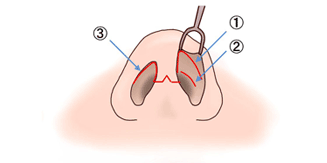
① Infracartilagenous incision
Closed approach
This method is an incision of the anterior margin of the alar cartilage.
② Intercartilagenous incision
Closed approach
This method is an incision between the alar cartilage and the upper lateral cartilage.
③ Transcolumellar incision
Open approach
This method is an incision of the columella.
We choose an appropriate incision site depending on the type of surgery in order to achieve the best results with minimal scarring.
Specifically, an infracartilagenous incision is a method used to correct a blunt nasal tip.
An intercartilagenous incision is used only when a glabellar implant is to be inserted or when an implant is to be removed.
A transcolumellar incision is used for caudal septal extension graft surgery and osteotomy.
It safely secures the surgical area and ensures accurate manipulation of cartilage grafts, osteotomies, and other structural changes.
Fees
All fees include tax.
| Surgery | Remarks | Fee |
|---|---|---|
| Augmentation Rhinoplasty | Hyaluronic acid injection | per 0.1cc \¥9,900 |
| Cleviel (a long-lasting hyaluronic acid) | per 0.1cc \¥13,200 | |
| Custom-made prosthesis (soft silicone or Gore-Tex) | ¥330,000 | |
| Special order prosthesis (including 3D modeling) | ¥440,000 | |
| Augmentation Rhinoplasty with autologous tissue | ¥440,000 | |
| Removal of Nasal Implant | After surgery at our clinic | ¥55,000 |
| After surgery at another clinic | ¥110,000 | |
| Nasal Tip Plasty | ¥385,000 | |
| Correction of Blunt Nasal Tip | ¥385,000 | |
| Correction of a Long Nose | ¥440,000 | |
| Alar Rim Resection | ¥330,000 | |
| Alar Rim Graft | ¥550,000 | |
| Caudal Septal Extension Graft Surgery (Lengthening of a Short Nose) | When using auricular cartilage | ¥660,000 |
| When using costal cartilage | ¥880,000 | |
| After surgery at other clinic | ¥330,000 | |
| Cartilage Grafting of Nasal Dorsum | ¥330,000 | |
| Correction of a Hump Nose | ¥660,000 | |
| Osteotomy | ¥660,000 | |
| Glabellar Augmentation Rhinoplasty | ¥330,000 | |
| Nasal Base Reduction | Medial Method | ¥330,000 |
| Lateral Method | ¥330,000 | |
| Medial Method + Lateral Method | ¥495,000 | |
| Revision Nasal Base Reduction | Standard surgery | ¥330,000 |
| Complex surgery involving tissue transfer and grafting | ¥550,000 | |
| Paranasal Augmentation with Implant | Standard surgery | ¥330,000 |
| Special order prosthesis (including 3D modeling) | ¥550,000 | |
| Correction of a Deviated Nose | Standard surgery | ¥660,000 |
| In combination with Caudal Septal Extension Graft Surgery or Osteotomy | ¥330,000 | |
| Alar Rim Raising | Standard surgery | ¥330,000 |
| In combination with Nasal Base Reduction | ¥165,000 |
Supervising Doctor
Under the supervision of our plastic surgeons, we operate our website in accordance with medical advertising guidelines.
NORIHIRO OHBA M.D. Ph.D.
HEAD DIRECTOR/DIRECTOR
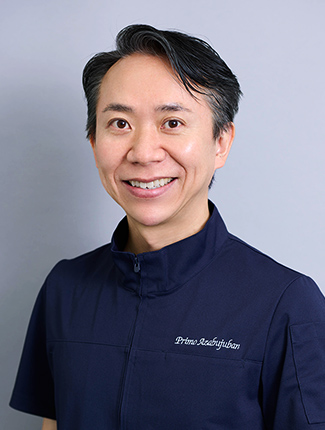
Qualifications and Academic Affiliations
Doctor of Medicine
Board Certified Plastic Surgeon, Japan Society of Plastic and Reconstructive Surgery
Board Certified Aesthetic Plastic Surgeon, Japanese Society of Aesthetic Plastic Surgery
Board Certified Aesthetic Plastic Surgeon, Japanese Society of Aesthetic Surgery
Anesthesiologist certified by the Ministry of Health, Labor and Welfare
Member of International Society of Aesthetic Plastic Surgery (ISAPS)
International Member of American Society of Plastic Surgeons (ASPS)
Member of Japan Society of Cranio-Maxillo Facial Surgery
Member of Japan Society of Laser Surgery and Medicine
Career
Graduated from Osaka City University Faculty of Medicine, 1996
Osaka City University Hospital Plastic and Reconstructive Surgery, 1996-1999
Osaka City University Graduate School of Medicine, 1999-2003
Osaka City University Hospital Plastic and Reconstructive Surgery, 2003-2005
Sano Memorial Hospital Plastic and Reconstructive Surgery(part-time)
Daito Central Hospital Plastic and Reconstructive Surgery(part-time)
Ritz Cosmetic Surgery Tokyo Clinic, 2005-2008
Primo Azabujuban Clinic, 2009~
Head Director, Primo Medical Corporation, 2011~
Head Director/Director, Primo Azabujuban Clinic, 2020~
